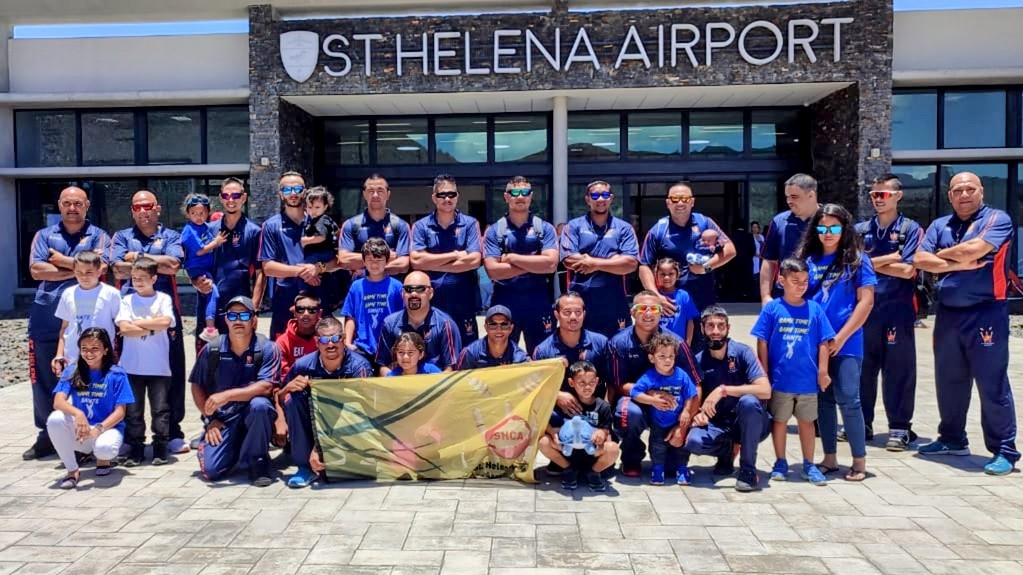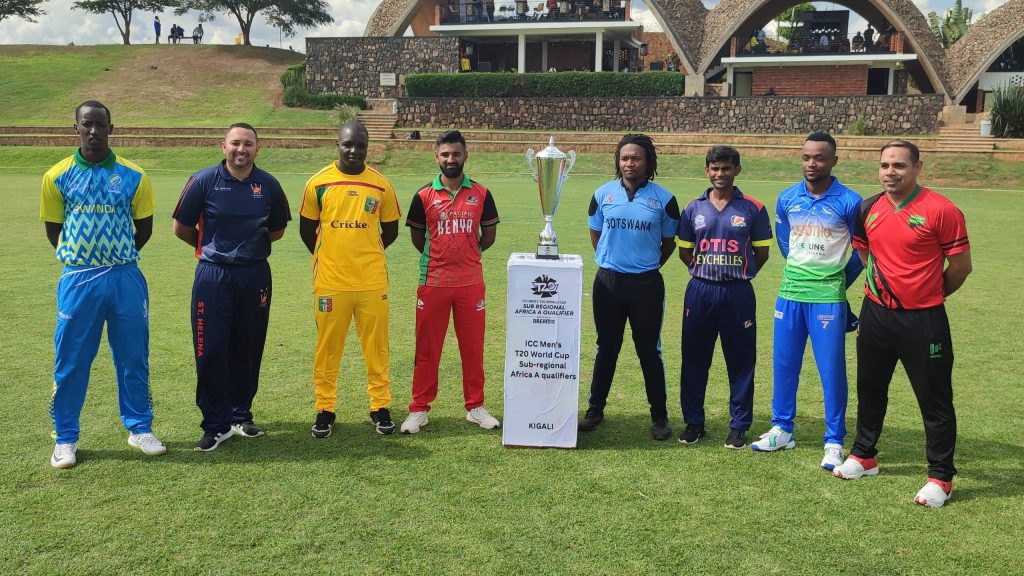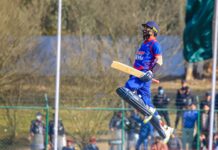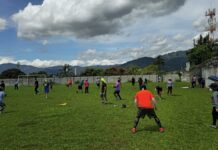Between November 17-25, a team from one of the most remote islands in the world will take on some of the biggest teams in African cricket for a shot at qualifying for the 2024 Men’s T20 World Cup.
St Helena is an island in the south Atlantic in between Namibia and Brazil. It has a population of just over 4000 people, and with just one flight a week, it’s one of the most remote specks of land on earth.
That hasn’t stopped it from sending a team 2500 miles away to the 2024 T20 World Cup “regional” qualifiers though, and with this World Cup expanded to 20 teams, they’ve never stood a better chance of making it to the tournament proper.

Who are St Helena and why is this significant?
Cricket is a big deal on this south Atlantic island.
The pavilion and grass banks around the island’s one cricket field at Francis Plain are rarely not filled with spectators looking for a spot to watch the day’s play from. Sat above a 300 foot rock face, it’s a picturesque setting.
It’s not just family and friends either. Cricket provides some quality live sport for those that make the trip down to the ground from every corner of the island, often with food and drink in tow. Appeals for LBW, and sixes clearing the boundary rope, draw shouts from the crowd that can be heard across the valley.
Cricket has been played on the island since at least the mid-1800s, around the same time as the sport was introduced to New Zealand and Sri Lanka, with its first official league established in 1903. As a participation sport, it remains relatively more popular than in many other places around the world.
Regular player turnout here is at a level that would make the ECB envious. During the cricket season, which runs from December through to about May, there are three different tournaments and a district team league.
From this local pool of players, a 16 man squad has been selected to compete against the best the Africa region has to offer. South Africa has already qualified by finishing in the top eight of this year’s T20 World Cup, leaving St Helena to face off against the best of the rest.
The format of the regional qualifier event means that the side will need to get past teams that include group opponents Kenya, Rwanda and Malawi amongst others, if they stand any chance of making it to the regional final.

All of these teams dwarf St Helena in terms of populations and resources. Most of St Helena’s opponents boast inhabitants in the many millions, compared to St Helena’s several thousand. Even The Seychelles, another small island territory, has approximately 25 times the population of St Helena.
Many of these teams have players with List A and First Class experience. Although now in his 40s, this even includes one of Kenya’s heroes from their 2003 World Cup Semi-Final run, Collins Obuya.
Kenya themselves held ODI status as recently as 2014. By contrast, St Helena only became an ICC associate member in 2017.
What has gone into getting here?
Despite the long and proud history of cricket on the island, this will only be St Helena’s third international tournament.
To get to their first international tournament just over a decade ago, the snappily named 2012 ICC World Cricket League Africa Region Twenty20 Division Three, the team had to raise £24,000 to fund the trip. They also had to begin and end their journey with a five day trip by sea on the RMS St Helena, the Royal Mail Ship being the only way on and off the island at the time.
Since then an airport has opened and the St Helena Cricket Association (SHCA) has been able to access finance from the Africa Cricket Association (ACA) Development Fund.
Even then, there’s no big money sponsorship deals or Allen Stanford characters (for better or worse) coming in to support the players or the team. That being said, they have managed to attract some much needed sponsorship locally.
Solomon and Company, a local firm covering everything from insurance to retail services, made a donation to the tour funds. This was notable for the fact that a previous owner of the firm, Humphrey Welby Solomon, was the founder of the SHCA in 1903. The firm has had a presence on the island that outstrips even cricket, having been founded in 1790.
A request to Airlink, the only airline that services St Helena, has led to two free air fares being provided to the group. This has meant that the team have been able to take a physiotherapist with them, currently on loan from the government health service, which should help get through the seven matches in nine days.
It also allowed them to bring professional ICC Level 3 Coach Mohammed Nadeem Ahmed, or “Coach Nadeem”, out to the island. He initially worked with a larger pool of players, before whittling it down to the final 16 and providing focused training over weeks leading up to the tournament. He’ll now remain with the team throughout their tour to Rwanda.
But what about the other costs? The SHCA generates a modest income through annual subs from players and teams in the leagues, which has helped find some of the money. The ACA Development Fund has also been vital to ensuring that the team can make the trip.
Beyond that, some of the cohort has actually funded the tour themselves. Denzel Pedro Smit, a development coach, joined the team in South Africa, saying he is “absolutely honoured to be invited to be a part of the St Helena National Team”.
Denzel had previously worked with the team in 2018 when St Helena travelled to Botswana and could not turn down another opportunity to work with them, even if it meant meeting much of the costs out of his own pocket.
Most international teams have a support network around them to help ensure they’re primed come tournament time. For most, that starts at club level and goes right through to the national team. St Helena’s size and resources means they don’t have that luxury. To have a manager, two coaches and a physio is something far beyond what the players experience at club level during their domestic season.
Wicketkeeper and Vice Captain Cliff Richards can already see the difference. “The arrival of coach Nadeem has been very beneficial to me in trying to perfect my wicket-keeping skills and understanding of the game, which I am sure everyone has found, as most skills are self-taught and coach has helped a lot with minor adjustments to our techniques”.

Playing on the international stage
Although it has a grass outfield, St Helena’s only cricket pitch features a concrete square with matting cover. This creates another challenge for the players, who might only get the chance to play on a grass wicket when they find themselves overseas.
Whilst allocated to the Africa ICC region, being over 1000 miles from mainland Africa and finances already tight, international opportunities are limited. Their first appearance at an international event in Botswana in 2012 saw them finish a respectable fifth out of eight teams. They then had to wait another seven years for their second appearance on the international stage, albeit under slightly different circumstances.
From January 2019, the ICC granted full international status to T20 men’s matches played between ICC member sides. That meant that for the first time, St Helena would be playing top-class status T20 Internationals.
This time around St Helena managed to finish an impressive third out of seven sides, with the top two sides progressing to the regional finals.
At that tournament Scott Crowie was Captain of the side and took two player of the match awards for his efforts with bat and ball. He’s been made captain of the side once again this time around.
Several sides the team faced in 2019 are in St Helena’s group for this tournament, including previous group toppers Botswana.
The team have the support of the whole island back home, but know it will be a challenging tour. To bring a bit of luck they’ve taken a locally made mascot with them. It’s a miniature replica inspired by the island’s senior resident, and oldest living land animal anywhere in the world, 190 year old Jonathan. Jonathan is a Seychelles giant tortoise and was brought to St Helena in 1882 from The Seychelles, their opponents on Tuesday.
This fact has not been lost on Team Manager Derek Richards. “I can’t imagine the look on the face of The Seychelles’ team when we rock up with one of their tortoises, which is older than any of theirs!”
If St Helena can make it into the top two come the end of the tournament they will progress to the regional finals alongside the first and second placed teams from the other Africa regional tournament. Of those four, two will be going to the T20 World Cup.
You can follow St Helena’s progress through the SHCA website, where they are posting regular updates.
You’re reading Emerging Cricket — brought to you by a passionate group of volunteers with a vision for cricket to be a truly global sport, and a mission to inspire passion to grow the game.
Be sure to check out our homepage for all the latest news, please subscribe for regular updates, and follow EC on Twitter, Facebook, LinkedIn and YouTube.
Don’t know where to start? Check out our features list, country profiles, and subscribe to our podcast.
Support us from US$2 a month — and get exclusive benefits, by becoming an EC Patron.






